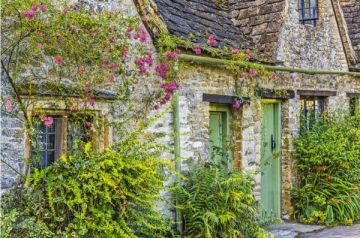
Summary
Batsford Arboretum is the largest and most extensive private collection of trees and shrubs in Britain. The arboretum shares space in Batsford Park with the Cotswold Falconry Centre. Batsford is home to over 2,800 labelled trees, shrubs, and bamboo, with some 1,300 unique species.
History
Batsford Arboretum was the brainchild of Algernon Bertram Freeman-Mitford, who inherited the Batsford estate in 1886. Freeman-Mitford, later the 1st Lord Redesdale, travelled widely throughout the Orient and was heavily influenced by Chinese and Japanese culture, philosophy, and horticulture.

Upon taking possession of Batsford, he created a unique mix of parkland and garden, with groupings of plants in imitation of Chinese style. Redesdale was an expert in bamboos, and many of the bamboo plants you can see today were his plantings.
Redesdale also began to plant unusual varieties of plants and trees, beside a 600-metre long watercourse. Included in his vision were a hermit's cave, rockery, and a Japanese rest house.
When Redesdale died in 1916 the Batsford estate passed to David Mitford, father of the famous (or infamous) Mitford sisters. The cost of maintaining the estate proved too great and Mitford sold the property to Gilbert Wills, who was later named the 1st Lord Dulverton.
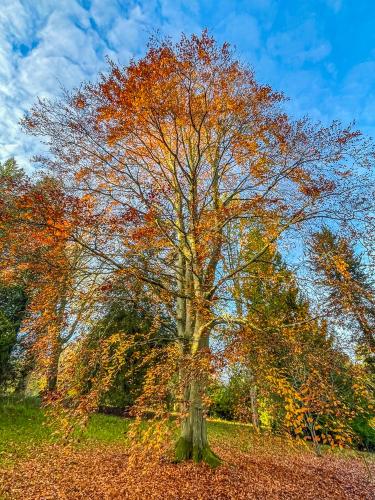
The gardens established by Lord Redesdale were greatly expanded by Frederick Hamilton Wills, 2nd Lord Dulverton, who inherited Batsford in 1956.
Dulverton's mantra was simply to collect rare and beautiful plants. To this end, he created nationally-important collections of species including Ash, Birch, Fir, Lime, Maple, Magnolia, Mountain Ash, Oak, Pine, and Spruce, among others.
It is to Lord Dulverton that Batsford owes a great deal of its appeal today; he added considerably to the collection of trees, creating at Batsford an arboretum of the highest international standards.
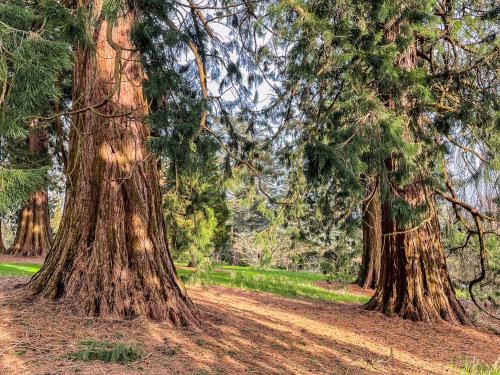
Garden Highlights
Anne Frank's Tree
Anne Frank, whose diary of her time in hiding from the Gestapo is one of the world's most beloved books, was in hiding, she could see a solitary chestnut tree from the window of her hideaway in Amsterdam. She mentioned the tree several times in her famous diary and talked about the joy and hope it gave her.
Though the original tree was destroyed in a storm in 2010, cuttings have survived in several places around the world, including here at Batsford Arboretum. On 25 September 2010 a cutting from the original tree was planted at Batsford with the aid of members of the Girl Guides, who were marking the Guides centenary.
The tree is thriving and can be seen off a footpath at the southern edge of the arboretum, off the path to the waterfall. An information panel tells the story of Anne Frank and the tree.

Historic Sculptures
There are five Grade II listed structures within Batsford Arboretum. Three of these are statues brought back to the UK by Lord Redesdale from his numerous trips to the Orient. One is a bronze sculpture of two deer, dating to the late 19th century. One of these is a stag, with antlers, and other is a female deer.
Nearby is a bronze statue of what the official Historic England listing calls a 'Chinese Style Lion' but the official Batsford visitor guide refers to as a 'Dog of Foo' of 'Foo Dog'. This statue also dates to the 19th century and shows a dog (or lion) with its foot on a cloisonné enamelled globe.
The third statue is perhaps the most interesting; it is also of bronze and depicts a seated Buddha. It was brought to the UK by Redesdale in 1900 but is of unknown age. The statue is roughly 2m high and shows Buddha in the lotus position, seated on a stone plinth.
In addition to these listed statues, there is a fourth statue in the arboretum, showing the mythological Greek nymph Daphne, who is traditionally linked with fountains, wells, and streams.
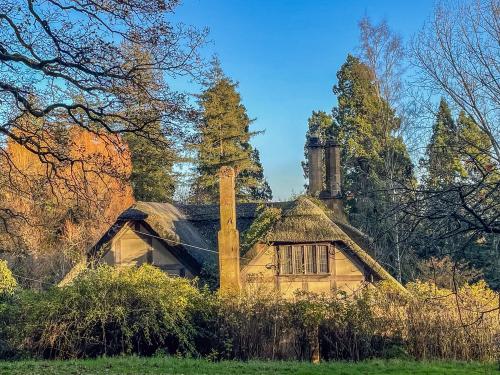
Thatched Cottage
The largest of the two Grade II listed buildings at Batsford, this picturesque thatched building was erected by Lord Redesdale in the late 19th century to serve as a dairy. It is built in attractive Arts and Crafts style with timber posts supporting a twin-gabled roof.
Japanese Rest House
A short distance from the Thatched Cottage is a Japanese Rest House, built for Lord Redesdale in the style of a traditional Japanese building. The bronze fish atop the roof finial is thought to come from Japan.
Hermit's Cave
This picturesque cave at the top of the site once had a resident hermit, hired by Lord Redesdale to provide entertainment for visitors to the estate.
Pocket Handkerchief Tree
One of Batsford's most popular trees, the Davidia involucrata (Pocket Handkerchief Tree) flowers for just a few weeks a year, usually in middle to late May, but the exact dates depend on the weather conditions.
The tree was found growing wild in China by the famous Victorian plant-hunter Ernest Wilson in 1901. Wilson sent seed samples back to Britain and Lord Redesdale planted his seeds around 1910. This is one of the largest pocket handkerchief trees ion the UK.

The Collections
Though the focus of Batsford is truly international, it is in the area of Oriental shrubs and trees that the collection shines. There are over 3,000 labelled plants, trees, and shrubs at Batsford. Notable varieties include oak, maple, mountain ash, magnolias, Japanese Cherries, bamboos, and pine.
Batsford holds the national collection of Japanese Village Cherries, meaning that it holds roughly 70% of known plants of this species.
Other major collections at Batsford include maple, pine, bamboo, oak, magnolia, and sorbus (mountain ash and whitebeam). The arboretum also holds endangered Chilean conifers as well as champion trees and 'red data' trees. Champion trees are the largest of their species and Red Data trees are either extinct or in danger of becoming extinct in the wild.
Batsford is home to a number of redwoods (Wellingtonias) including Giant Redwoods, Dawn Redwoods, and Coast Redwoods.
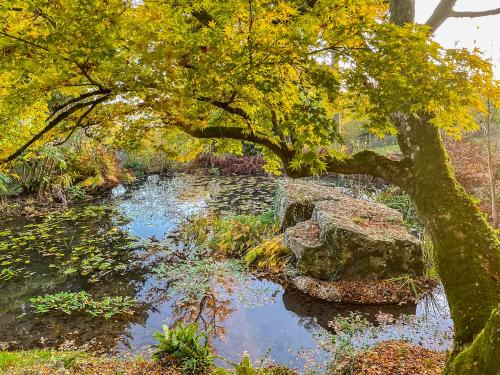
Horticultural Highlights Through the Seasons
Spring (March-May)
The arboretum bursts into life with one of the UK's largest collections of Japanese flowering cherries, creating a spectacular display of pink and white blossoms. Magnificent magnolias, including Magnolia campbellii and Magnolia x soulangeana, produce their robust blooms against the awakening landscape. The Japanese Maples begin their yearly show with fresh spring growth in vibrant reds and lime greens.
Spring Highlights:
- Magnolia (March)
- Japanese Cherries
- Eastern Redbud
- Mount Fuji Cherry
- Handkerchief Tree (May)
- Wild Garlic
- Snowdrops (February)
- Hellebores (February)
- Daffodils (March)
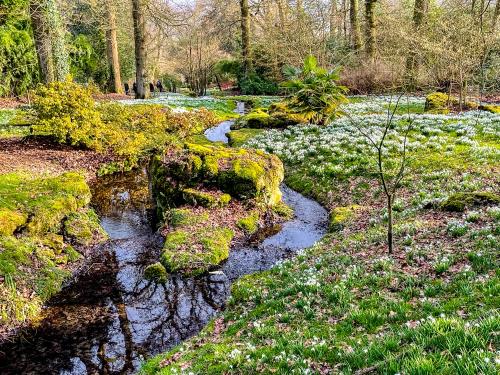
Summer (June-August)
Summer brings a more subtle beauty to Batsford, with the mature canopy providing welcome shade. The National Collection of Japanese Village Cherries reaches full leaf, while the wildflower meadows attract numerous pollinators. The bamboo collection, one of the largest in Britain, displays its architectural qualities.
Summer Highlights:
- Japanese Dogwood
- Hydrangeas
- Native wildflowers
- Bamboo
- Spotted orchids
- Moon daisies
- Foxgloves
- Forget-me-knots
- Buttercups
Autumn (September-November)
Batsford truly excels in autumn, when the extensive collection of Japanese Maples (Acer palmatum and related species) transforms into a blazing palette of crimson, orange, and gold. The arboretum's strategic design ensures that autumn colour progresses through the grounds in waves, providing several weeks of spectacular displays.
Autumn Highlights:
- Japanese Maples
- Sweet Gum
- Swamp Cypress
- Mountain Ash
- Katsura
Winter (December-February)
The winter months reveal Batsford's structural elements, with the bare branches of ancient specimens creating dramatic silhouettes. The extensive collection of evergreens provides year-round interest, while winter-flowering specimens offer unexpected colour.
Winter Highlights:
- Witch Hazel
- Helleborus collection
- Silk Tassel Bush
- Wintersweet
- Snowdrops (February)
- Aconites

Conservation and Education
Today, Batsford Arboretum plays a crucial role in plant conservation and environmental education. The collection includes several rare and endangered species, particularly from East Asia. The arboretum's staff actively participate in seed exchange programmes with other botanical institutions worldwide and maintain detailed records of their specimens for research purposes.
The visitor centre and educational facilities offer regular workshops, guided tours, and school programmes, helping to inspire the next generation of horticulturists and botanists. The arboretum also serves as a living laboratory for studying climate change impacts on various tree species.
Visiting
Fee charged. For current details see the official website. A combined ticket allowing entry to the Arboretum and Falconry Centre is available. Immediately outside the eastern edge of the arboretum, at the end of Peaches Walk, is Batsford's Victorian parish church, which is well worth a visit.
About Batsford Arboretum
Address: Batsford Park,
Batsford,
Moreton in Marsh,
Cotswolds,
Gloucestershire,
England, GL56 9QB
Attraction Type: Garden
Location: Off the A44 Moreton-in-Marsh to Bourton-on-the-Hill. No entry through Batsford village.
Website: Batsford Arboretum
Email: arboretum@batsfordfoundation.co.uk
Location
map
OS: SP186338
Photo Credit: David Ross and Britain Express
HERITAGE
 We've 'tagged' this attraction information to help you find related historic attractions and learn more about major time periods mentioned.
We've 'tagged' this attraction information to help you find related historic attractions and learn more about major time periods mentioned.
Find other attractions tagged with:
NEARBY HISTORIC ATTRACTIONS
Heritage Rated from 1- 5 (low to exceptional) on historic interest
Batsford, St Mary's Church - 0 miles (Historic Church) ![]()
Bourton House Garden - 1 miles (Garden) ![]()
Sezincote - 1.9 miles (Historic House) ![]()
Longborough, St James - 2.6 miles (Historic Church) ![]()
Four Shire Stone - 2.9 miles (Historic Building) ![]()
Stretton-on-Fosse, St Peter's Church - 3.6 miles (Historic Church) ![]()
Evenlode, St Edward's Church - 3.6 miles (Historic Church) ![]()
Todenham, St Thomas of Canterbury Church - 3.8 miles (Historic Church) ![]()
Nearest Holiday Cottages to Batsford Arboretum:
Moreton-in-Marsh, Gloucestershire
Sleeps: 6
Stay from: £572 - 3559
Chipping Campden, Gloucestershire
Sleeps: 4
Stay from: £569 - 1740
More self catering near Batsford Arboretum













